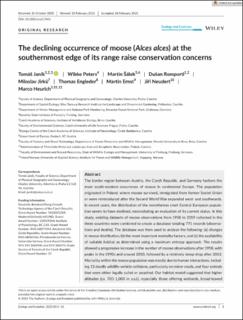| dc.description.abstract | The border region between Austria, the Czech Republic, and Germany harbors the most south-western occurrence of moose in continental Europe. The population originated in Poland, where moose survived, immigrated from former Soviet Union or were reintroduced after the Second World War expanded west and southwards. In recent years, the distribution of the nonetheless small Central European population seems to have declined, necessitating an evaluation of its current status. In this study, existing datasets of moose observations from 1958 to 2019 collected in the three countries were combined to create a database totaling 771 records (observations and deaths). The database was then used to analyze the following: (a) changes in moose distribution, (b) the most important mortality factors, and (c) the availability of suitable habitat as determined using a maximum entropy approach. The results showed a progressive increase in the number of moose observations after 1958, with peaks in the 1990s and around 2010, followed by a relatively steep drop after 2013. Mortality within the moose population was mostly due to human interactions, including 13 deadly wildlife-vehicle collisions, particularly on minor roads, and four animals that were either legally culled or poached. Our habitat model suggested that higher altitudes (ca. 700–1,000 m a.s.l.), especially those offering wetlands, broad- leaved forests and natural grasslands, are the preferred habitats of moose whereas steep slopes and areas of human activity are avoided. The habitat model also revealed the availability of large core areas of suitable habitat beyond the current distribution, suggesting that habitat was not the limiting factor explaining the moose distribution in the study area. Our findings call for immediate transboundary conservation measures to sustain the moose population, such as those aimed at preventing wildlife-vehicle collisions and illegal killings. Infrastructure planning and development activities must take into account the habitat requirements of moose. | en_US |

